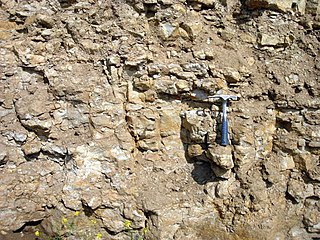
The Ordovician is a geologic period and system, the second of six periods of the Paleozoic Era. The Ordovician spans 41.6 million years from the end of the Cambrian Period 485.4 million years ago (Mya) to the start of the Silurian Period 443.8 Mya.

Acritarchs are organic microfossils, known from approximately 1800 million years ago to the present. Their diversity reflects major ecological events such as the appearance of predation and the Cambrian explosion.

Hiiumaa is the second largest island in Estonia and is part of the West Estonian archipelago, in the Baltic Sea. It has an area of 989 km2 and is 22 km from the Estonian mainland. Its largest town is Kärdla. It is located within Hiiu County.

Dorothy Hill, AC, CBE, FAA, FRS was an Australian geologist and palaeontologist, the first female professor at an Australian university, and the first female president of the Australian Academy of Science.
Edward Oscar Ulrich was an invertebrate paleontologist specializing in the study of Paleozoic fossils.

Thelodus is an extinct genus of thelodont agnathan that lived during the Silurian period. Fossils have been found in Europe, Asia and North America. Unlike many thelodonts, species of Thelodus are known not only from scales, but from impressions in rocks. Some species, such as the Canadian T. inauditus, are thought to be comparable in size to other thelodonts, i.e., from 5 to 15 centimeters in length. The scales of the type species, T. parvidens of Silurian Great Britain, however, reach the size of coins, and, if proportioned like other thelodonts, such as Loganellia, the living animal would have been about one meter in length.
Dolerorthis is an extinct genus of hesperorthid brachiopod. The type species of this genus, D. interplicata, was described from the Silurian (Telychian) Osgood Formation. Other species belonging to this genus are known from the Ordovician and Silurian of Europe, Kazakhstan, China and Argentina. It was roughly 4 centimetres (1.6 in) across.
In the geological timescale, the Llandovery epoch occurred at the beginning of the Silurian period. The Llandoverian epoch follows the massive Ordovician-Silurian extinction events, which led to a large decrease in biodiversity and an opening up of ecosystems.

Founded in 1938, the Estonian Academy of Sciences is Estonia's national academy of science in Tallinn. As with other national academies, it is an independent group of well-known scientists whose stated aim is to promote research and development, encourage international scientific cooperation, and disseminate knowledge to the public. As of March 2017, it had 77 full members and 20 foreign members. Since 15 October 2014, the president of the Academy is the mathematician Tarmo Soomere.

Kukersite is a light-brown marine type oil shale of Ordovician age. It is found in the Baltic Oil Shale Basin in Estonia and North-West Russia. It is of the lowest Upper Ordovician formation, formed some 460 million years ago. It was named after the German name of the Kukruse Manor in the north-east of Estonia by the Russian paleobotanist Mikhail Zalessky in 1917. Some minor kukersite resources occur in sedimentary basins of Michigan, Illinois, Wisconsin, North Dakota, and Oklahoma in North America and in Amadeus and Canning basins Australia.
Sphaerocoryphe is a genus of trilobite that lived from the middle Ordovician to the Silurian. Its fossils have been found in Australia, Europe, and North America. Both Sphaerocoryphe and Hemisphaerocoryphe had a characteristically bulbous glabella, and the two may represent only one genus.

Tigridia pavonia is the best-known species from the genus Tigridia, in the family Iridaceae. Common names include jockey's cap lily, Mexican shellflowerpeacock flower, tiger iris, and tiger flower. The species is widespread across much of Mexico as well as Guatemala, El Salvador, and Honduras. The species is also considered naturalized in Ecuador and Peru.
Similodonta is an extinct genus of early bivalve in the extinct family Praenuculidae. The genus is one of eleven genera in the subfamily Praenuculinae. Similodonta is known from Middle Ordovician through Middle Silurian fossils found in Europe and North America. The genus currently contains eight accepted species, Similodonta ceryx, Similodonta collina, Similodonta djupvikensis, Similodonta magna, Similodonta recurva, Similodonta spjeldnaesi, Similodonta wahli and the type species Similodonta similis.

Graptolitic argillite is a marinite-type black shale of sapropelic origin. It is a blackish to greyish lithified claystone. The known occurrence of this rock is a graptolitic argillite of the Türisalu Formation in northern Estonia and northeast Russia. It is correlated with Swedish alum shale being its younger facial eastward continuation, and both being a part of the Baltoscandic Cambrian-Ordovician black shale, together with black shales in the Oslo region in Norway, Bornholm, Denmark, and Poland. Other known occurrences are in North America, the Malay Peninsula, and New Zealand.

Catenipora is an extinct genus of tabulate corals in the family Halysitidae, known from the Ordovician to the Silurian.
Craniops is an extinct genus of brachiopods in the family Craniopsidae with species known from the Ordovocian to the Devonian.

Charles Stokes was a London stockbroker who gained a reputation both as an amateur scientist and as an art collector.

Holophragma is an extinct genus of rugose coral known from Ordovician and Silurian rocks in Scandinavia, Russia, Australia and the United States. Two of its species can be found on the northwestern coast of Gotland, where it is one of the most common fossil genera. It was described by Gustaf Lindström in the year 1896. The genus contains two species.

Phaulactis cyathophylloides is an extinct species of rugose coral known from the silurian layers of Gotland, and Estonia. It is the type species of the genus Phaulactis and was described by Ryder in 1926. It can grow to relatively large sizes.













